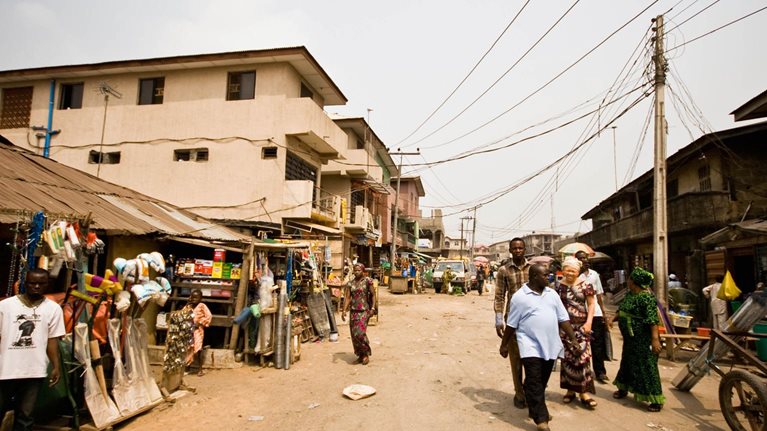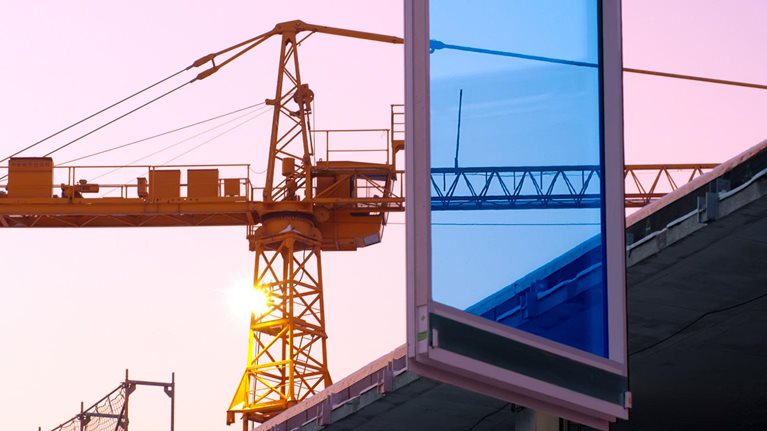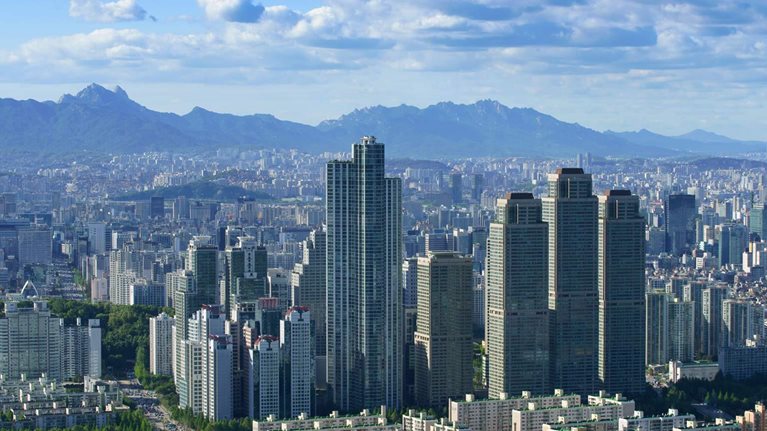“If you’ve never had the experience of moving into your own city, you should try it sometime,” Stan Gale said with a chuckle, waving at the towers climbing around us on all sides—condos, offices, even South Korea’s tallest building, the 1,001-foot Northeast Asia Trade Tower. Gale, chairman and managing partner of Gale International, had borrowed $35 billion from Korea’s banks and partnered with its biggest steel company to build a city from scratch the size of downtown Boston, only taller and denser, on a muddy man-made island in the Yellow Sea. He’d cut the ribbon only days before, although his creation won’t be finished until 2015.
Songdo isn’t so much a Korean city as a Western one floating just offshore from Seoul. It was chartered as an “international business district”—a hub for companies working in China. Worried about being squeezed by its neighbors, Songdo is Korea’s earnest attempt to build an answer to Hong Kong. To make expatriates feel at home, its malls are modeled after those in Beverly Hills, and Jack Nicklaus designed the golf course. But its most salient feature is shrouded in a perpetual haze on the other end of a 12-mile-long bridge that is one of the world’s longest. That’s the home of Incheon International Airport, which opened in 2001 on another man-made island and instantly became one of the world’s busiest hubs.
“They tracked us down, wanted us to build a city in the ocean, and no one else was interested,” Gale told me, still dazed. “Their vision scared everyone else away. It wasn’t until I saw the airport that I understood where they wanted to go with this.” Where they wanted to go was China. His sales pitch to prospective tenants is simple: move here, and you’re only a two-hour flight away from Shanghai or Beijing, and four hours away at most from cities you’ve never heard of, like Changsha. Chairman Mao’s hometown happens to be larger than Atlanta or Singapore. Nearly a billion people are just a day trip away. When Stan Gale looks at a departure board, he sees a treasure map. And when he gazes upon his creation, he sees dozens of potential new cities, each next to a dot on that map. These cities-to-be even have a name, which Gale pronounces for me with a flourish, an “aerotropolis.”
It isn’t his word. The man who taught it to him is John Kasarda, a professor at the University of North Carolina who has made a name for himself with his radical (and some might say bone-chilling) vision of the future: rather than banish airports to the edge of town and then do our best to avoid them, Kasarda believes we will build this century’s cities around them. Why? Because people once chose to live in a city for the wealth of connections it offered socially, financially, intellectually, and so forth. But in the era of globalization, we choose cities that have access to other cities, linked by fiber-optic cables and jet aircraft. Stan Gale is simply taking this idea to its logical conclusion, building a network of instant aerotropoli joined by their airports.
Many aerotropoli have evolved out of the cities we already call home. The edge cities of Fairfax and Loudoun Counties, in Virginia—the most affluent counties in the nation—were the product of nearby Dulles International Airport. Orange County’s airport has more Class A office space nearby than all of downtown Los Angeles. And the notion of “Dallas–Fort Worth” didn’t exist until the airport bearing that name opened between them, causing the rival cities to merge.
To create more instant cities similar to Songdo, Kasarda has drafted a set of blueprints replete with “air trains” connecting prefab neighborhoods and business districts. They range in size from a few thousand residents to a few million. Aerotropoli designed according his principles are under way across Africa, China, India, and the Middle East and on the fringes of cities as desperate as Detroit and as old as Amsterdam. But Songdo didn’t set out to be like any of these. It was commissioned as a weapon.
In the aftermath of the Asian financial crisis of 1997–98, the International Monetary Fund (IMF) handed South Korea a $58 billion bailout, with conditions. One was a command to seek foreign investment. By then, however, its manufacturing base was decamping to China—70 percent of its factories left over the next decade. Trade between the two countries didn’t exist in 1980, but 25 years later China would be its largest trading partner. Eager to follow the flying geese once more as its factories vanished into the Delta, Korean leaders resolved to make Seoul the financial and creative hub of northeast Asia—a title for which there was no end of contenders.
South Korea’s capital is the archetypal 20th-century megacity, doubling in size every decade or so since 1950 to 24 million inhabitants—the second most populous on Earth, after greater Tokyo. But badly scarred by the Korean War, Seoul buried its landscape under mammoth apartment blocks and epic traffic jams. As an aspiring cool city, it offered little to card-carrying members of the creative class, and less than Hong Kong or Singapore—the preferred postings of Western expatriates. So Korea would have to build a new city up to their standards.
Where? Hemmed in by mountains on two sides, a demilitarized zone on a third, and the Yellow Sea on another, Seoul had reached the limits of expansion. But as Dubai would prove, coastline can be manufactured. In the 1990s, Korean officials decided to build a new international airport on landfill off the coast of Incheon, the neighboring port where General Douglas McArthur and the US Marines had stormed ashore in 1950. Not stopping there, engineers raised thousands of additional acres for future development. The airport opened in 2001; reclamation continues to this day.
That same year, the government went looking for some Americans to build the cool city it couldn’t. One of its agents stumbled across Stan Gale on the Web; his partner tried to blow him off, saying he was in the middle of a really big deal. “You don’t know what big is,” he was told. Seduced by the possibilities, Gale would eventually commit to building a pocket-sized Manhattan on 1,500 acres of mud, with a daytime population of 300,000 and 65,000 permanent residents. It was scheduled to take 15 years.
The task of designing an instant city fell to Gale’s architects at Kohn Pedersen Fox (KPF), whose lengthy resume includes supertall skyscrapers and dozens of corporate headquarters, but nothing on the order of Songdo. The principal in charge of the project is Jamie von Klemperer, whose willingness to explain himself in simple English sets him apart from his starchitect peers.
Previous attempts at conceiving instant cities had been hobbled by their own utopianism, he explained one afternoon at KPF’s Manhattan offices, as we watched his assistants carve matchstick skyscrapers out of Styrofoam. In trying to draft the perfect city, he said, architects had produced inhuman ones. “Renaissance planners would take a circle and decide what geometry of roads, what uses, and what utopian order would be given to that circle,” he said. This thinking still lurks behind the layouts of built-to-order capitals like Washington, DC, and Brasília. “They weren’t particularly pleasant places to live. And so we made a point to avoid abstraction, choosing collage instead.”
Songdo cherry-picks the signatures of universally beloved cities and recycles them as building blocks. The city trumpets itself as an amalgam of New York, Venice, and Savannah. In practice, this means its streets and Central Park are modeled on Manhattan’s, its canal inspired by Venice, and its gardens borrowed from Savannah’s. The product is an eerily familiar mix tailor-made for the homesick “global business class with a morning meeting in Seoul and an afternoon one in Beijing,” as von Klemperer describes its intended residents.
On my first visit to Songdo, in 2007, the city was still a mud pile. Roaming the floodplain where Central Park would be, I stumbled over clamshells—a stark reminder that all this had recently been underwater. Two years later, on the park’s opening day, I closed my eyes in an ersatz teahouse along the water’s edge, listening to cicadas in the saplings and children whizzing by on bicycles, their laughter interrupted by the percussion of pile drivers. The park itself was a manicured landscape of pine forests, boulders and flowerbeds—an obvious fake. Then again, so were the hills, lakes and ice-skating rinks in the original Central Park. Like any perfect knockoff, Songdo had obliterated the distinction between the counterfeit and the real.
Songdo has also been designed to be the greenest, most energy-efficient city in the world. Just as it copied great cities’ best features, it’s rounding up the state-of-the-art in sustainable technologies and taking them to scale the way only an instant city can. All of its water and waste will be recycled, for instance. Rainwater and “graywater” will be collected for cooling and irrigation, while solid waste will be burned for heat and electricity. These will in turn be recycled to warm Songdo’s buildings, using a centralized approach known as “district heating.” The goal is to use 30 percent less water than a city its size, and save 75 percent of its trash from landfills.
The buildings will boast solar panels and sod on their roofs, specially glazed windows, and superefficient fixtures for efficient heating, cooling, and ventilation. Even their concrete will be made green by using 20 percent less cement, which means 20 percent less electricity consumed in making it. And because Songdo had the opportunity to install its infrastructure first, three stops on the Seoul/Incheon subway were running before the city even opened.
On top of that, Songdo will be intrinsically green for the same reason Manhattan is: density. Calculated by the square foot, the original “Terminal City” looks like an environmental Chernobyl of greenhouse gases, garbage, noise, and traffic. But re-run the numbers by resident or by household, and the city is practically Eden. Manhattanites consume gasoline at a rate the United States hasn’t seen since the 1920s, and 82 percent of its residents commute via public transit, by bicycle, or on foot. If all Americans lived like New Yorkers do, our carbon emissions would drop 71 percent. We wouldn’t need a cap on carbon; we would have already done it on our own.
Green Metropolis author David Owen argues “dense urban centers offer one of the few plausible remedies for some of the world’s most discouraging environmental ills. To borrow a term from the jargon of computer systems, dense cities are scalable, while sprawling suburbs are not. The environmental challenge we face, at the current stage of our assault on the world’s nonrenewable resources, is not how to make our teeming cities more like the pristine countryside. The true challenge is how to make other settled places more like Manhattan.” By cramming its 65,000 eventual residents into two and a half square miles, Songdo has done exactly that—their densities are almost identical.
The results are eye opening. If all goes according to plan, Songdo’s carbon footprint will be one-third of a city its size—a big step toward the reductions needed to halt global warming. There is, of course, the environmental absurdity of erecting a sustainable city on former wetlands, but as Jamie von Klemperer would counter, it’s a better alternative than clear-cutting mountains.
Not only is it both green and an aerotropolis, Songdo is meant to be a “smart city” too. As preached by technology companies such as Cisco and IBM, the Internet will be the next big utility, tying all other utilities together. Hook cities up to the right mix of sensors and software, their thinking goes, and who knows what efficiencies might be revealed? When buildings, power lines, gas lines, roadways, cell phones, residential systems, and so on are able to talk to one another, that information can expose hidden patterns of waste and help discover ways to avoid it. Just as wiring corporations made them leaner and meaner, wiring cities may be one way to tease efficiency out of dumb networks like the power grid. Songdo will be the first city-wide experiment.
While still a long way from being finished, this pocket city is arguably the nicest in Korea. The Koreans themselves seem to think so—even during a housing bust, its apartment blocks have all been instant sellouts. As population pressure mounts not just on Seoul but in cities across Asia, Songdo’s pragmatic pastiche may become the template for all the instant cities to come. Stan Gale has assembled a dream team of architects and technologists to make sure it does. Paired with Cisco’s smarts, 3M’s green materials, United Technologies’ engineers and KPF’s blueprints, Gale won’t be content until he can mass-produce cities in half the time it takes for China to do so.
Indeed, Songdo’s first clone may break ground this year on the outskirts of Chongqing, a city in western China growing at superhuman speeds. It will be twice as large as its parent, but just as dense, smart, and green. This and every subsequent city will be standardized around his partners’ products: the same light fixtures, traffic signals, elevators, fuel cells, air conditioners, and sensors. It’s the only way to build them in time for the tidal wave of new inhabitants.
“We’re trying to replicate cities,” said Cisco’s chief globalization officer Wim Elfrink, but “we have no standards. Every city is a new project, a new process, a new interface,” he told me in Songdo, marveling at the inefficiency of it all. “You shouldn’t spend time on an elevator. You shouldn’t spend time on lighting.” You should spend time planning the next city. Gale’s timetable is, if anything, too slow for Cisco, which has signed deals with additional instant cities in India, Qatar, and Saudi Arabia—all of which will also be aerotropoli.
“Everything can be connected and everything can be green,” Elfrink promises, and his customers are dying to believe him. The implicit promise of a sustainable world is one in which 6.5 billion people—or, in 40 years, 9 billion—live like Americans, only with no penalty to the planet. It’s the promise of taking the definition of an unsustainable way of life to global scale without deprivation and without poisoning ourselves. Stan Gale and Kasarda both propose matching scale with scale, cloning cities (one green, and one connected) that reflect the competing needs of the Instant Age, walking a tightrope between delivering prosperity and triggering peak oil, peak food, and peak everything. At a time when many of us are calling for simplicity—a way of life that is more local and thus buffered against peak oil and climate change—Gale is building just the opposite, in a place that needs his services most: China.


